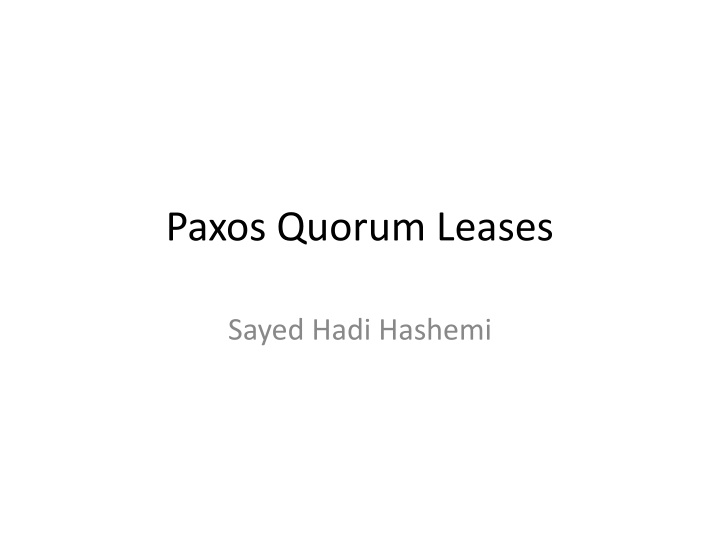
Quorum Leases in Distributed Systems
Learn about Quorum Leases in distributed systems, how they optimize read and write operations, and their benefits compared to traditional approaches like Multi-Paxos. Explore the concept of multiple leases for different sets of objects, local reads, and synchronous write notifications through lease grantors.
Download Presentation

Please find below an Image/Link to download the presentation.
The content on the website is provided AS IS for your information and personal use only. It may not be sold, licensed, or shared on other websites without obtaining consent from the author. If you encounter any issues during the download, it is possible that the publisher has removed the file from their server.
You are allowed to download the files provided on this website for personal or commercial use, subject to the condition that they are used lawfully. All files are the property of their respective owners.
The content on the website is provided AS IS for your information and personal use only. It may not be sold, licensed, or shared on other websites without obtaining consent from the author.
E N D
Presentation Transcript
Paxos Quorum Leases Sayed Hadi Hashemi
Setting Status: Key-Value Storage Commands: Read / Write / Batch (Read, Write) Goal: Minimized WAN Delay Original Paxos Read: At least 2 RT (more in case of dueling leaders) Write: At least 2 RT
Paxos Can we do any better? Client Result / ACK Request (CMD) Replica 0 Prepare OK Accept (CMD) Accept (OK) Committed (CMD) Replica 1 Replica 2 RT RT
Multi Paxos Temporary Stable Leader Replica to ignore Prepare (election) phase Read: 1 RT from the leader Write is the same as the read A replica becomes the stable leader by running the prepare phase for a large number of instances at the same time, taking ownership of all of them. Google s Megastore All Replica are leader! Read: 0 RT from any Replica! (Reading Locally) Write: At least 1 RT to All Replica
Steady state interaction in Multi-Paxos. The asynchronous messages are represented as dashed arrows. Client Result/ACK Request (CMD) Leader Replica 0 Accept (CMD) Accept (OK) Committed (CMD) Replica 1 Replica 2 RT
Megastore Client Request (Read) Result Request (Write) ACK Replica 0 Accept (OK) Accept (CMD) Committed (CMD) Replica 1 Replica 2 RT
Can we have benefits of the both? Quorum Leases Middle ground Read: Most of the time 0 RT (80% in the experiment), 1 RT otherwise Write is almost the same as the Multi Paxos
Overview The idea is to have multiple leases for different sets of objects Each lease is granted to lease holders by a majority of grantors Read: Lease holders can read locally while the lease is active Any one else, use Multi-Paxos Write: Notify Lease holders synchronously through Lease Grantors (Majority)
Lease Configuration Describes the set of granted objects to quorum leases Replica is added to a lease if it reads an object frequently Replica is removed from a lease if it fails, or it stop reading an object frequently Granting and Refreshing leases |N+1|/2 grantors will activate a lease for a set of holders Grantor Promise Holder that: Notify r synchronously before committing any update Acknowledge Accept and Prepare for writing with the condition that the proposer must notify r synchronously
Grant Lease t_lease1 T1 T3 T5 t_guard t_lease2 Grantor Promise ACK Guard ACK Guard Promise Holder t_lease t_guard T2 T4 1. if Promise ACK has received 2. if Promise ACK has not received
Grant Renew t_lease t_lease1 T1 T3 T5 t_guard t_lease2 Grantor Promise ACK Promise ACK Guard ACK Guard Promise Promise Holder t_lease t_guard t_lease T2 T4 T6 1. if Promise ACK has received 2. if Promise ACK has not received
Evaluation Run implementations of quorum leases, classic leader leases and Megastore-type leases Geo-distributed Amazon EC2 cluster. 5 Multi-Paxos replicas in Virginia, Northern California, Oregon, Ireland and Japan. 10 Client co-located in each replica Workload YCSB key-value workload (Zipf) Uniform key-value workload
Test1: Latency Evaluation Multi-Paxos Leader: Northern California Each client sends 10000 request to its co- located replica Request: 1:1 Read-Write 9:1 Read-Write Parameters: lease duration: 2s, renew duration: 500ms, lease configuration update: every 10s
Test2: Recovering from a Replica Failure Shutdown a (non leader) replica, 10s after starting the test (Lease Configuration Update) Parameters: Guard duration: 2s, Grace delay: 5s, lease duration: 2s, renew duration: 500ms, lease configuration update: every 10s Recover time: Update + Grace + Guard + Lease
Test3: Throughput in a Cluster Run in one local cluster (no geo-distributed) Requests are generated open-loop by one client for each replica 2 Situations: (1) different objects are popular at different replicas (2) clients direct their reads uniformly at random across all replicas. Use batching to commit writes (the leader batches up to 5000 updates at a time)
Pro Strong Consistency Acceptable Availability Combine the best of two approaches Using objects, instead of Replica Separating Lease Configuration Updates than the other operations Compatibility with Multi-Paxos (or other implementations)
Cons What is the messaging overhead? Lease Renewal Lease Configuration Experiment 1:1 Read-Write Ratio vs. 9:1 Recovery Time in Practice: Update + Grace + Guard + Lease Worse case +20s
Thanks for your attention QUESTIONS?
